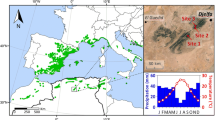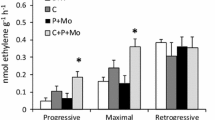Abstract
We report observations of disappearance of Erica tetralix in wet heathland, which is unlikely to be caused by competition, as E. tetralix is dying before its place is taken up by other species. To investigate the causes, we used both old and new data. Results showed that presence of Molinia caerulea and Calluna vulgaris were substantial in the former E. tetralix dominated areas. Measurements of the C/N ratio in the morlayer were between 21 and 26 under the E. tetralix stands. As the expected C/N ratio in a healthy nutrient poor ecosystem like the E. tetralix wet heathland is around 30, this indicates that the ratio is probably decreasing and, correspondingly, the probability of nitrogen leaching from the ecosystem is increasing. The morlayer pH was extremely low—between 3.03 and 3.78. This represents a pH decline since the 1960s, where pH values generally were above 4. This supports the hypothesis that the decrease in morlayer pH is the major factor explaining the disappearance of E. tetralix and that measures to increase pH should be considered as part of the recommendations for relevant future management.






Similar content being viewed by others
References
Aerts, R., and F. Berendse. 1988. The effect of increased nutrient availability on vegetation dynamics in wet heathlands. Plant Ecology 76: 63–69.
Bååth, E., and K. Arnebranth. 1993. Microfungi in coniferous forest soils treated with lime or wood ash. Biology and Fertility of Soils 15: 91–95.
Bobbink, R., D. Boxman, E. Fremstad, G. Heil, A. Houdijk, and J. Roelofs. 1992. Nitrogen eutrophication and critical load for nitrogen in European heathlands. In Critical Loads for Nitrogen—A Workshop Report. Nord, Vol. 41, 125–139.
Bobbink, R., and J.P. Hettelingh. 2011. Review and revision of empirical critical loads and dose–response relationships. In Proceedings of an Expert Workshop, Noordwijkerhout, 23–25 June 2010. RIVM Report: 680359002. ISBN: 978-90-6960-251-6.
Bobbink, R., K. Hicks, J. Galloway, T. Spranger, R. Alkemade, M. Ashmore, M. Bustamante, and S. Cinderby. 2010. Global assessment of nitrogen deposition effects on terrestrial plant diversity: A synthesis. Ecological Applications 20: 30–59.
Børgesen, F., and C. Jensen. 1904. Utoft heath plantation. Botanisk Tidsskrift 26: 177–221. (in Danish).
Bruus, M., K.E. Nielsen, C. Damgaard, B. Nygaard, J. Fredshavn, and R. Ejrnæs. 2010. Terrestrial Naturtypes 2008. NERI Technical Report No. 765. Aarhus: DMU, Aarhus University (in Danish). http://www.dmu.dk/udgivelser/faglige_rapporter/nr750_799/abstracts/fr765/.
Calvo, L., R. Tarrega, and E. Luis. 2002. Regeneration patterns in a Calluna vulgaris heathland in the Cantabrian mountains (NW Spain): effects of burning, cutting and ploughing. Acta Oecologica 23: 81–90.
Damgaard, C. 2008. Modelling pin-point plant cover data along an environmental gradient. Ecological Modelling 214: 404–410.
Damgaard, C. 2009. On the distribution of plant abundance data. Ecological Informatics 4: 76–82.
Dorland, E., R. Bobbink, J.H. Messelink, and J.T.A. Verhoven. 2003. Soil ammonium accumulation after sod cutting hampers the restoration of degraded wet heathlands. Journal of Applied Ecology 40: 804–814.
Ellermann, T., C. Nordstrøm, J. Brandt, J. Christensen, M., Ketzel, and S.S. Jensen. 2010. The Danish air quality monitoring programme. Annual summary for 2009. NERI Technical Report No. 799. Aarhus: National Environmental Research Institute, Aarhus University. http://www.dmu.dk/udgivelser/faglige_rapporter/nr750_799/.
Finlay, R.D. 2008. Ecological aspects of mycorrhizal symbiosis: with special emphasis on the functional diversity of interactions involving the extraradical mycelium. Journal of Experimental Botany 59: 1115–1126.
Galløe, O., and C. Jensen. 1906. Vegetation in Borris Hede. Botanisk Tidsskrift 27: 249–275. (in Danish).
Gimingham, C.H. 1972. Ecology of heathlands. London: Chapman and Hall.
Hansen, K. 1976. Ecological studies in Danish heath vegetation. Dansk Botanisk Arkiv 31: 1–118.
Horswill, P., O. O’Sullivan, G.K. Phoenix, J.A. Lee, and J.R. Leake. 2008. Base cation depletion, eutrophication and acidification of species-rich grasslands in response to long-term simulated nitrogen deposition. Environmental Pollution 155: 336–349.
Hovmand, M., and L. Petersen. 1984. The Acidification Project: Soil Acidification. Copenhagen: Danish Environmental Protection Agency (in Danish). http://www.mst.dk/Publikationer/Publikationer/1984/01/87-503-4829-9.htm.
Jensen, R.H., and K.M. Jensen. 1979. The development of the agricultural landscapes in the parishes Borris and Sdr. Felding in Vestjutland, mainly based on map interpretation. Geografisk Tidsskrift 78–79: 61–97 (in Danish, extensive English summary). http://www.tidsskrift.dk/visning.jsp?markup=&print=no&id=71056.
Kent, A., and P. Coker. 1992. Vegetation Description and Analysis—A Practical Approach. New York: Wiley.
Lange, TR. 1995. Competition Between Calluna vulgaris og Erica tetralix in Lønborg Heath. Specialerapport. Aarhus: Biological Institute, Århus University.
Lövblad, G., C. Persson, T. Klein, T. Ruoho-Airola, M. Hovmand, L. Tarrason, K. Tørseth, and L. Rapp. 2004. The Deposition of Base Cations in the Nordic Countries. IVL-Report B 1583. Gothenburg: Swedish Environmental Research Institute.
Lovett, G.M., T.H. Tear, D.C. Evers, S.E.G. Findlay, B.J. Cosby, J.K. Dunscomb, C.T. Driscoll, and K.C. Weathers. 2009. Effects of air pollution on ecosystems and biological diversity in the Eastern United States. Annals of the New York Academy of Sciences 1162: 99–135.
Maskell, L.C., S.M. Smart, J.M. Bullock, K. Thompson, and C.J. Stevens. 2010. Nitrogen deposition causes widespread loss of species richness in British habitats. Global Change Biology 16: 671–679.
Nielsen, K.E., J.L. Bak, M. Bruus, C. Damgaard, R. Ejrnæs, J.R. Fredshavn, B. Nygaard, F. Skov, B. Strandberg and M. Strandberg. 2011. Data paper—Danish monitoring program of vegetation and chemical plant and soil data from non-forested terrestrial habitat. Global Index of Vegetation Plot Databases. http://www.givd.info/db_details.html?choosen_db=281&choose=Load.
Pilkington, M.G., S.J.M. Caporn, J.A. Carroll, N. Cresswell, G.K. Phoenix, J.A. Lee, B.A. Emmett, and T. Sparks. 2007. Impacts of burning and increased nitrogen deposition on nitrogen pools and leaching in an upland moor. Journal of Ecology 95: 1195–1207.
Pitcairn, C.E.R., D. Fowler, and J. Grace. 1995. Deposition of fixed atmospheric nitrogen and foliar nitrogen content of bryophytes and Calluna vulgaris (L.) Hull. Environmental Pollution 88: 193–205.
Raunkiær, C. (1909) Investigations and statistics of plant formations. Botanisk Tidsskrift 30, 20–132 (in Danish) (In English in Ch. 6 in Raunkiær. (1934). Investigations and Statistics of Plant Formations, 201–282).
Stevens, C.J., K. Thompson, J.P. Grime, C.J. Long, and D.J.G. Gowing. 2010. Contribution of acidification and eutrophication to declines in species richness of calcifuge grasslands along a gradient of atmospheric nitrogen deposition. Functional Ecology 24: 478–484.
Strandberg, M., C. Damgaard, K.E. Nielsen, and H.J. Degn. 2011. Status and Possibilities for Management in Wet Heathlands. NERI Technical Report 820 (in Danish, English summary). http://www.dmu.dk/udgivelser/faglige_rapporter/nr800_849/.
Strandberg, M., and M. Johansson. 1999. Uptake of nutrients in Calluna vulgaris seed plants grown with and without mycorrhiza. Forest Ecology and Management 114: 129–135.
Svendsen, L.M., L. van der Bijl, S. Boutrup, and B. Norup. 2005. NOVANA. National monitoring and assessment programme for the aquatic and terrestrial environment. programme description—Part 2. NERI Technical Report No. 537. http://www.dmu.dk/udgivelser/faglige_rapporter/nr_500-549/.
Vergeer, P., R. Rengelink, N.J. Ouborg, and J.G.M. Roelofs. 2003. Effects of population size and genetic variation on the response of Succisa pratensis to eutrophication and acidification. Journal of Ecology 91: 600–609.
Acknowledgments
Thanks to Jesper Heile Christensen for providing the nitrogen deposition data, to Ole Pedersen for pointing out suitable places for transect analyses on Borris Hede, to the Danish Armed Forces/Ole Noe for financial support, and to Charlotte Kler for checking English writing.
Author information
Authors and Affiliations
Corresponding author
Electronic supplementary material
Below is the link to the electronic supplementary material.
Rights and permissions
About this article
Cite this article
Strandberg, M., Damgaard, C., Degn, H.J. et al. Evidence for Acidification-Driven Ecosystem Collapse of Danish Erica tetralix Wet Heathland. AMBIO 41, 393–401 (2012). https://doi.org/10.1007/s13280-012-0251-z
Received:
Revised:
Accepted:
Published:
Issue Date:
DOI: https://doi.org/10.1007/s13280-012-0251-z




